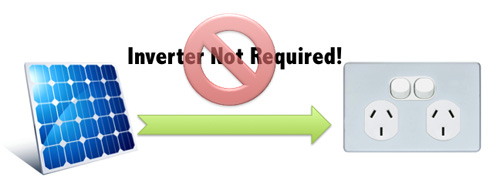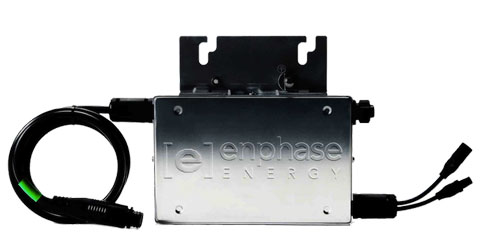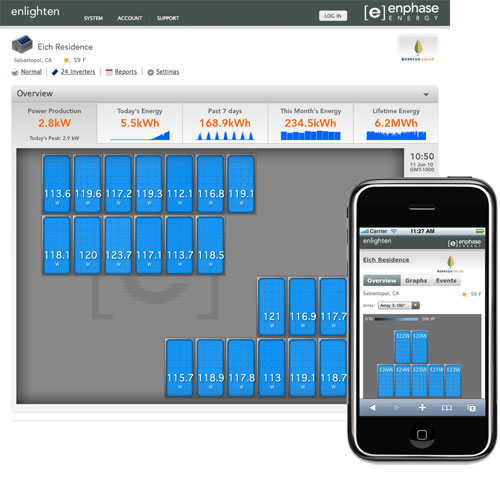Will 2012 be the year of the AC Solar Panel?
Before answering that question I should probably explain exactly what an AC Solar Panel is…
What is an AC Solar Panel?
The short answer is: An AC Solar Panel is a solar panel that takes sunlight in and spits AC (Alternating Current) electricity out. This compares to a “conventional” DC Solar Panel which takes sunlight in and spits DC (Direct Current) electricity out.
AC Electricity is the type of electricity you need to power the appliances in your home. DC panels need a Solar Inverter to convert the DC electricity to AC. The big advantage of AC panels is that there is no need for an inverter to do that conversion, so you have a really simple design, a simpler installation, and adding extra panels becomes almost plug and play.
How Does An AC Solar Panel Work?
The silicon solar cells (the square black things, the size of beer-mats) that typically make up crystalline solar panels cannot create AC electricity from sunlight. They will always output DC. The way to get AC out of the panel is to add a “microinveter” about the size of a cigar box to the back of each panel. This is simply a mini version of a standard solar inverter, that performs the inverter duties for only the solar panel that it is attached to. The nice thing about having one microinverter for each solar panel is that you will get 5-15% more power from each panel. Why? Because every solar panel will have slightly different electrical characteristics due to imperfect manufacturing tolerances. The micro inverters can optimise their function to each individual panel, instead of making a compromise that suits all the panels on your roof. This individual optimisation squeezes more power from each panel.
If the microinverters are networked, then it also makes troubleshooting a cinch. Good microinverters will come with web based monitoring software that will monitor individual panels and sound the alarm if a single panel drops in power relative to the rest. This is usually caused by bird poo! But at least now you know for sure when to get your ladder and damp cloth out!
If it is so easy to install an AC Solar Panel, do you need a solar installer at all?
Well, the solar installers aren’t quaking in their boots quite yet, for the following reasons:
- To get the solar rebate in Australia the whole installation needs to be designed and supervised by a Clean Energy Council (CEC) Accredited installer.
- You will still need a licensed electrician to connect the AC wires into your fusebox and install safety disconnect switches etc.
- Working on a roof is pretty dangerous (just ask Rod Hull) and, unless you enjoy the sound of raindrops falling on your head whilst you watch TV, drilling into your roof to mount the panels is probably best left to trained installers.
- Just buying the hardware for a “DIY Solar Kit” in the USA actually works out as the same price as a fully installed system here in Australia. Westinghouse Solar are now selling DIY Solar Kits in the US based on their latest AC Solar Panels. If you live in the US you can buy a 1.5KW DIY kit here for US $5,846. This compares to a 1.5kW system fully installed (before rebates) here in Australia for $5,800 ($2,800 after rebates). So the AC solar panel prices have a way to fall before “DIY solar” using AC panels makes financial sense compared to a professional install.
Who is making AC Solar Panels?
If you want to buy AC panels right now, the three manufacturers I know of are Westinghouse Solar, Exeltech (both USA based) and brand new Adelaide based PV Manufacturer Tindo Solar.
If you want to use conventional panels, but with micro inverters then I would recommend Enphase micro inverters.
Is the future solar panel AC or DC ?
I guess it is time for me to actually answer the question at the top of this post now… Will 2012 be the year of the AC solar panel?
I think it will take longer than 12 months, but I think that innovative companies like Tindo Solar and Westinghouse are on to something, and the rest of the Solar Industry will start to catch on. As electricity becomes more precious, and homes become more reliant on solar to provide the bulk of their energy, the advantages of AC solar panels will become irresistible.
With their better power harvesting, simple install, simple expansion options and monitoring software that even my grandpa could understand (Bird Poo Alert! Bird Poo Alert!) I predict that AC panels will become the default choice for residential solar power systems within the next 3 years.
UPDATE: I’ve just added a much more detailed guide to AC Solar Panels and Microinverters.




 RSS - Posts
RSS - Posts



It appears to me that you are straight up & know your stuff, keep up the good work. people like me need help,I’m a pensioner, not flush with funds, but I am very interested in having solar power. Is there a scheme of some sort which enables one to pay off a solar system ? More homes would fit them I’m sure if that were possible.
Hi Mal,
Thanks for your input!
In terms of financing solar power, your current options are (in order of lowest interest rate first):
1) add it to your mortgage (probably out of the question as a pensioner!)
2) get a green loan from a credit union like this one
3) take financing from your local solar installation company
If you check out my solar calculator you can plug in the numbers and check if it is worthwhile or not. I would argue that if you can make your [new electricity bill + repayments] to be less than your current electricity bill then it makes a lot of sense…
Hi Finn, great topic. Are there any current solar installers who use AC panels? Also is there a marked price difference in getting a 5kw DC system vs a 5kw AC system for example? I like how the Enphase micro inverters have 25yr warranty which matches the 25yr warranty on most panels. I noticed the Tindo Solar panels only warrant the micro-inverter for 20yrs.
I believe the parent company of Eco Kinetics recently bought out Westinghouse Solar who are one of the few AC panel manufacturers in the world. So they may start offering them soon.
Also Tindo Solar based here in Adelaide will soon have their factory churning them out. If you give them a call – they have set up a network of installers who sell their panels.
Hi Finn, most interesting to read your advice. I am just about to have a 2.5 kw system installed in mid June. If at a later date I find I need to generate more power, is it possible to add 1 or more Tindo or other AC panels to my existing system as finance allows and if so what could I expect to pay per unit ?
PS the system I am awaiting installation by Suntrix is 8×250 panels plus inverter, not AC panels. Thankyou.
Yes – you can add AC panels to any system, just be aware that the first panel will be the most expensive to add because you’ll need to run a separate AC cable from the first AC panel to your meter box. Additional AC panels can then use that cable too. (Your existing system will have a cable, but it will be carrying DC power so it can’t be used). To buy the panels, expect to pay about $600 per 250 Watt panel.
2 points:
1) will these micro inverters lose efficency with heat or fail?
2) current costs are very high considering the older style inverters / other panels quoted $3.25 p/w, new manufacturer would be using latest best production lines etc to manufature so surely costs should be closer?
Hi Rory,
Answers:
1) The good micro inverters will go up to about 80degC without derating, so temperature should not be an issue anywhere in Australia.
2) It is new technology – so the AC panels are more expensive than the established tech. The price differential will start top narrow with time. On a cost per kWh over 10 years the extra cost could probably not be justified economically right now – they will generally sell to people that want the latest technology and who get turned on by the individual panel monitoring software!
Hi Fin. We have had at least six quotes for solar and only one company has offered us AC solar panels. We love the concept. We have been quoted $8700 for 8 x 250 watts installed. Is that expensive in today’s environment?
$8700 is *very* expensive for a 2kW system. An AC system should cost about 20-30% more than DC. Current pricing for a good 2kW system is about $3700. So I’d look to pay no more than $5k for a 2kW AC solar system.
Hi Finn,
The link to your other article appears to be broken 🙁 I am interested in the idea of AC panels from the budgeting – add a few as you can afford angle. However, we have a 3 phase supply (and use it!) – are there microinverters for 415Volt? Our other option is the smaller 3 phase inverters from fronius and SMA (Coming soon I believe from investigating the whirlpool forum) but then there is the problem of number of panels to add at time – minimum startup voltages etc. Any advice would be appreciated – from reading various forums I am not alone in having 3 phase and preferring to input in 415V.
Sorry for the broken link – it’s fixed now. It should have been: http://www.solarquotes.com.au/ac-solar-panels.html
To use 3 phase and microinverters you would have to take the single phase output of the microinverters and put it in one of your 3 phases, but this might cause problems with phase balancing.
More details on 3 phase and solar here: http://www.solarquotes.com.au/blog/3-phase-solar-what-you-need-to-know-about-connecting-solar-to-your-3-phase-supply/
Hi Finn,
Do you know if the AC panels are compatible with battery backup?
Thanks
IN theory – yes. Although I’ve never seen it. You would need to convert the 240V down to 12 or 24V, but that is cheap and easy to do.